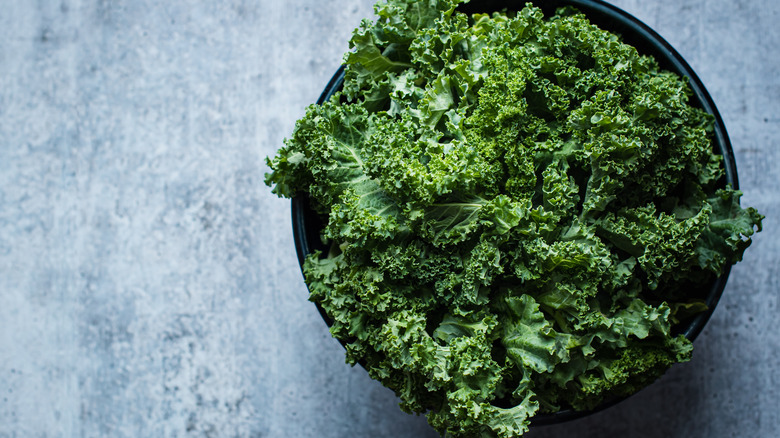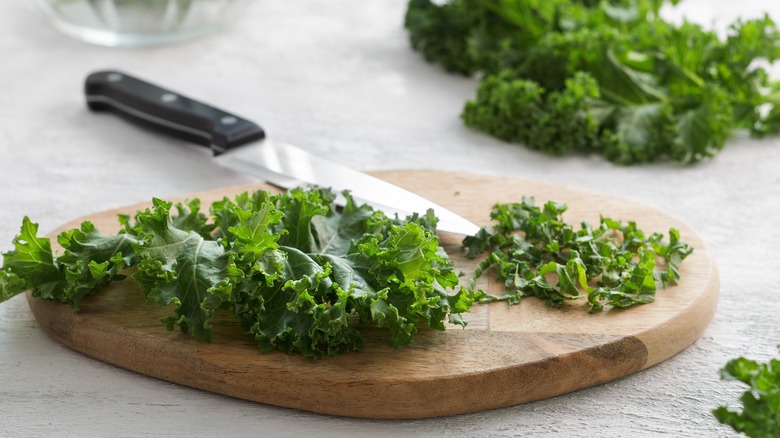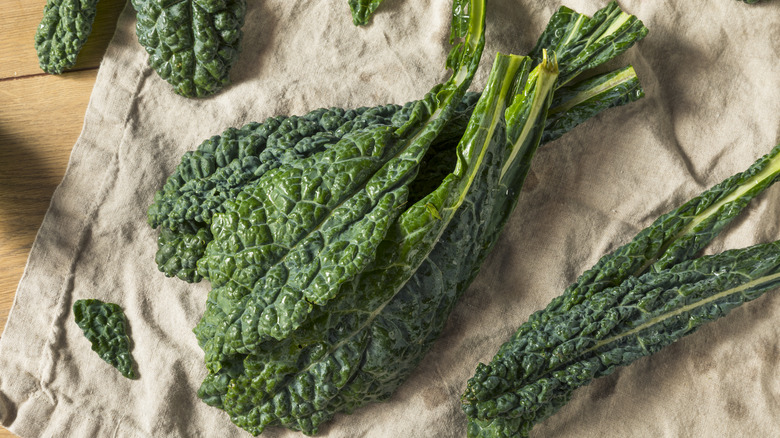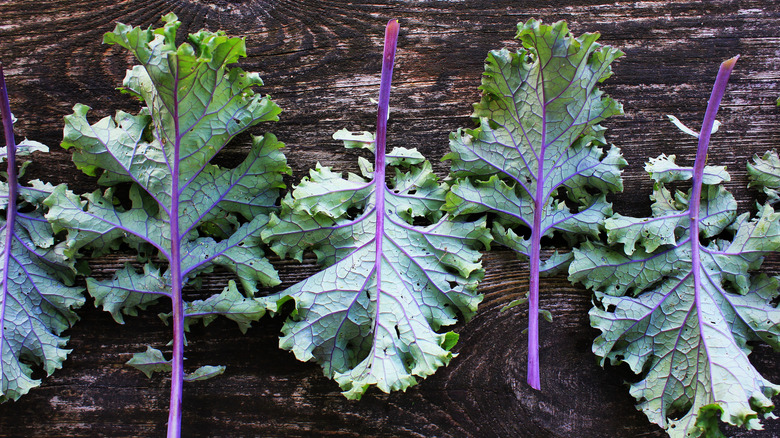Curly Vs Tuscan Vs Russian Red: What's The Difference Between These Types Of Kale?
You might think of kale as that one coarse and fibrous leaf with a robust, bitter flavor — an extremely nutritious cruciferous vegetable that you add to soups, juices, smoothies and salads, or bake into crisp chips. But did you know that there are approximately 150 varieties of kale, each slightly different in flavor, texture, and appearance from the other? Among the most popular ones that you're most likely to come across in supermarkets are curly, Tuscan, and Russian red kale.
The difference between these three varieties is obvious from the moment you look at them. Curly kale — as the name suggests — has densely packed, curled and crinkled leaves. These oblong fronds have a bright green-blue tint and are flecked with white veins. On the flip side, Tuscan kale has flat, narrow, and dark green leaves with a blue or gray tint, which are thinner than the curly variety. Perhaps the most distinct part about Tuscan kale though is its pebbled surface. The leaves are dotted with tiny bumps which give it a texture that's almost like dinosaur skin, hence why it is also known as dinosaur kale.
Then there is Russian red kale, which is entirely different from both the curly and Tuscan varieties. This kale can be recognized by its thick and fibrous reddish-purple stem, which is lined with flat blue-green leaves. The leaves have fringed, ruffled edges which resemble oak leaves or give it the appearance of a larger variant of arugula.
Curly is the most common variety of kale
Also known as winterbor, Scottish, or blue curled scotch, curly kale is the variety that you're most likely to see in stores. It has hard and fibrous stems that are best discarded, and its leaves are thick and tough. This kale has a robust earthy and peppery flavor that is more bitter than Tuscan and Russian red kale.
Curly kale is ideally used in cooked recipes. Its tough texture tenderizes when it is blanched, braised, or simmered in liquids, and it's a sturdy leaf that can hold its shape when sautéed or stir-fried. Curly kale also fares well when baked in an oven, thanks to its frilly edges which get really crisp and crunchy. So, if you're looking for the right variety of leafy greens to use in this curried coconut kale crisps recipe, choose curly kale over the others.
If you absolutely must eat it raw, it's best to prep curly kale first. Consider massaging the leaves with an acid (think lemon juice) and salt before you begin, as this can help tenderize the leaves when they aren't cooked. Moreover, massaging (followed by chopping) can also rid kale of some of its bitter flavor compounds. When you do chop these tough leaves, make sure to slice them into really fine shreds — the finer they are, the easier they will be to eat. Finally, consider seasoning with salty flavors like Parmesan, as this too can fix the bitter taste in kale.
The versatile Tuscan aka dinosaur kale
You may know Tuscan kale as dinosaur or lacinato kale, or by its Italian moniker cavolo nero, meaning black cabbage (though it's neither black nor a cabbage). Its long, pebbled leaves have a mild peppery flavor and a sweet, nutty aftertaste. Though its stems are just as tough and woody, Tuscan kale's leaves are more tender and less bitter than their curly counterparts. As a result, it's one of the best types of kale to eat raw.
Nevertheless, if you find that raw Tuscan kale is still a tad bitter or astringent for your liking, you can always cook it too. Doing so will tone down these flavors and bring out its sweetness instead. In fact, this kale is cooked in several traditional Tuscan recipes, including the winter vegetable soup ribollita and minestrone — especially since its flavor pairs well with beans which are used in both soups. Boiled Tuscan kale is often sautéed in lemon and garlic, and then spooned over bread to make cavolo nero crostini. It is added to pasta, turned into quiche, and even pounded into the regional, Tuscan version of pesto made using walnuts. Or, you can always turn dinosaur kale into a pizza with pickled onions.
The only thing to remember when cooking tender Tuscan kale is that it softens more quickly than curly kale. It's easy to overcook these greens (which will result in them losing their chewy bite) if you don't watch them closely.
Russian red is the most vibrant kale of the three
Russian red is the easiest of the three varieties of kale to identify — thanks to its purple, red, and burgundy stems which branch out into flat leaves with reddish veins. Moreover, its distinct hue only gets deeper and more vibrant in colder temperatures. It's also the mildest and sweetest variety of kale in the trio, with a flavor that's slightly earthy, peppery, and nutty.
Though Russian red's leaves are meaty in their own right, they are much more tender compared to curly and Tuscan kale. The leaves' edges tend to be particularly soft, whereas the rest can be juicy yet a tad hearty. In that case, you can always massage these leaves as you would curly kale.
Like Tuscan kale, Russian red too can be eaten either raw or cooked. As a bonus, its deep hue will only add a beautiful pop of color to your dishes. This kale also goes fabulously with meats like pancetta, pork, and sausage, or with aromatics like garlic, onions, chiles, caraway, and thyme. No matter how you choose to eat it, toss its stems out — they are far too tough to be edible. Another thing to note is that though all varieties of kale contain more or less the same nutritional value, Russian red may have a higher number of antioxidants than the others. This is because of the presence of pigments like carotenoids and anthocyanins which give the kale its purplish tint.




